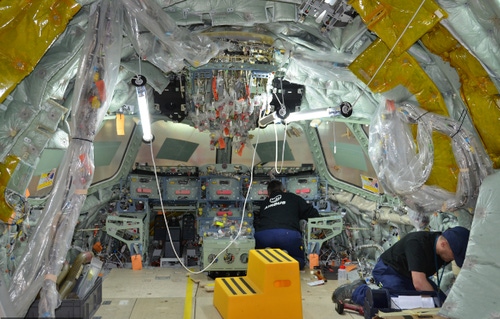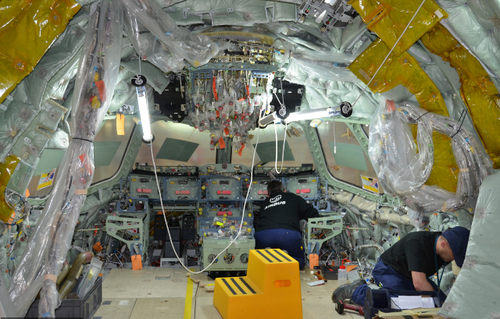Mechatronics Matches Growing Complexity of Intelligent Factories Step for Step
June 24, 2015

The Internet of Things is requiring the design of devices using engineering skills and knowledge in multiple domains: electronics, mechanics, control systems, software, and telecommunications, to name a few. In other words, the IoT needs mechatronics.
Perhaps an illustration of how design engineering today is propelling mechatronics, National Instruments (NI) is a $1.2 billion global technology firm that provides solutions for testing, monitoring, embedded systems, communications, and robotics across a variety of industries, from which none makes up more than 15% of company revenues.

Andy Chang, a mechanical engineer who is senior manager for academic research at NI, said that in a traditional development environment, "you'll have a group of mechanical engineers purely focusing on the mechanical design, say, of a vehicle," and when the mechanical group is finished with its side of the platform, "they toss the concept over the wall to a bunch of electronics or control engineers to work on the controls for the machine."
As mechanical, electronic, and control systems for a product become more complex, Chang believes, this kind of siloed approach is less likely to result in a manufacturable, viable product due to system incompatibilities and inefficiencies. "We've seen the need to create a much more unified workflow," he said, which is what NI has focused on in the development efforts of its own products.
MORE FROM DESIGN NEWS: B&R Automation Is Bullish on Connectivity and Smart Machinery Operations
Chang admits that the mechatronics development model hasn't penetrated every company and industry where it might be useful.
"We see a sprinkle of adoption across multiple industries -- automotive, aerospace, medical devices. Big companies like GM and Chrysler have a very well-defined structure and product development standpoint," he said. "For them to fully embrace the concept of mechatronics across disciplines is going to take time. That said, we're already seeing some research and development divisions looking into these concepts and planning to incorporate some elements over the next 10 years."
Where Chang sees much greater adoption of mechatronics-based development is among the more nimble small and medium-size enterprises. Smaller startups often have to operate with scarce resources and are under pressure to take a technology from concept to product in a short amount of time. In such an environment, a team of cross-trained mechatronics engineers can save on personnel costs and accelerate the design process by more readily jumping from electronics to mechanics to software development.
Nonetheless, some large manufacturers are finding applications for mechatronics design methods. NI's technologies and approach to system design have contributed to the Factory of the Future R&D project at Airbus.
MORE FROM DESIGN NEWS: What Industrial Companies Must Do for Effective IIoT Telemetry
The key to the Factory of the Future effort is the development of a set of "smart tools" for such tasks as drilling, measuring, tightening, and live logging of quality data.
The manufacturing and assembly of an aircraft involves a multitude of minute steps. One error by an operator can delay production and cost hundreds of thousands of dollars. Airbus thinks it can better manage and monitor its operators' tasks by adding intelligence to tools and shop floor systems.
Consider the task of tightening. According to Sebastien Boria, who leads R&D mechatronics technology at Airbus, one of its aircraft subassemblies "has roughly 400,000 points that need to be tightened down." The current production process requires some 1,100 tightening tools and a complex list of steps, including specific torque settings at each location and the tool that must be used.
Understandably, Boria said, "human error adds a lot of risk to the production." A smart tightening tool "understands which task the operator is about to perform using vision to process its surroundings and automatically set the torque." The outcome can be sent to the factory's manufacturing execution system (MES), which manages all the data from such processes.
Airbus has used NI's LabVIEW and System on Module (SOM) hardware platform to prototype these smart tools. A mechatronics approach was essential, since the tools' electronic, mechanical, and data communications elements need to function as a single efficient system -- all the while being simple and usable for the human operator. Boria said that the NI platform has provided a "ubiquitous architecture and framework" that has allowed the Airbus teams "to accelerate the development process from design to prototyping to deployment" of the smart tools.
Al Bredenberg is a writer, analyst, consultant, and communicator. He writes about technology, design, innovation, management, and sustainable business, and specializes in investigating and explaining complex topics. He holds a master's degree in organization and management from Antioch University New England. He has served as an editor for print and online content and currently serves as senior analyst at the Institute for Innovation in Large Organizations.
About the Author(s)
You May Also Like





